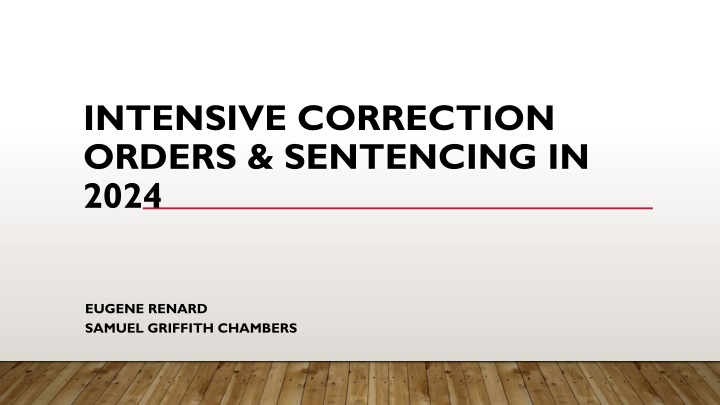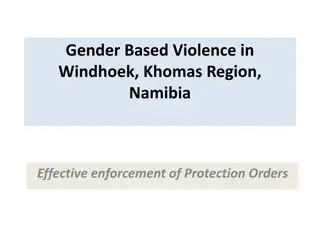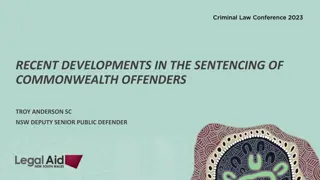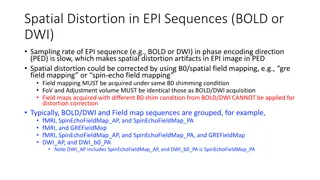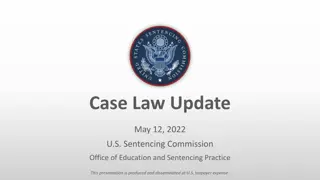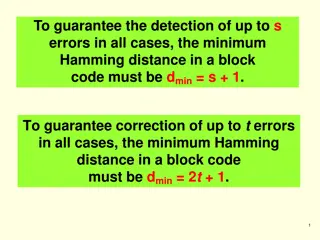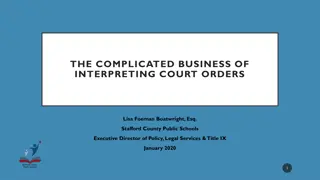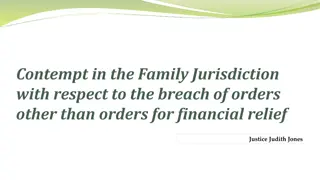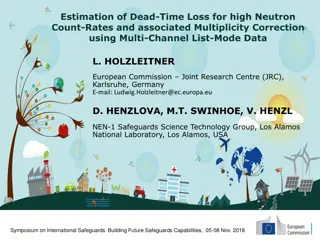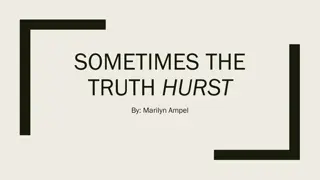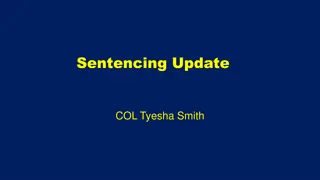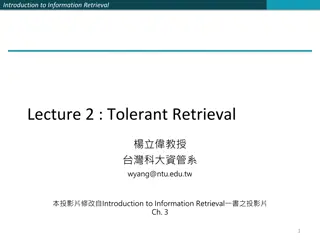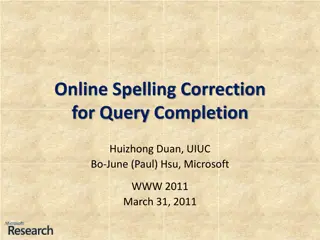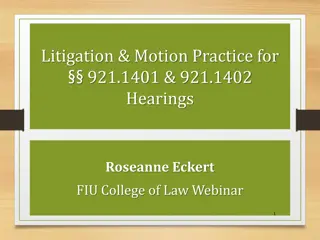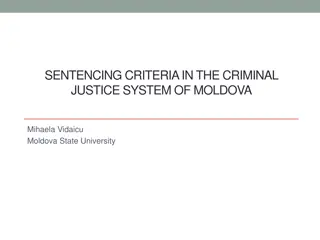Intensive Correction Orders & Sentencing Procedures
An Intensive Correction Order (ICO) is a custodial sentence that can be imposed if the court deems no alternative is suitable. The sentencing process involves determining the sentence length and whether an ICO is appropriate for community safety. Specific considerations apply to domestic violence offenses, and certain offenses are precluded from ICO eligibility.
Download Presentation

Please find below an Image/Link to download the presentation.
The content on the website is provided AS IS for your information and personal use only. It may not be sold, licensed, or shared on other websites without obtaining consent from the author.If you encounter any issues during the download, it is possible that the publisher has removed the file from their server.
You are allowed to download the files provided on this website for personal or commercial use, subject to the condition that they are used lawfully. All files are the property of their respective owners.
The content on the website is provided AS IS for your information and personal use only. It may not be sold, licensed, or shared on other websites without obtaining consent from the author.
E N D
Presentation Transcript
INTENSIVE CORRECTION ORDERS & SENTENCING IN 2024 EUGENE RENARD SAMUEL GRIFFITH CHAMBERS
WHAT IS AN ICO? AN ICO IS A CUSTODIAL SENTENCE WHICH CAN ONLY BE IMPOSED IF THE COURT IS SATISFIED THERE IS NO POSSIBLE ALTERNATIVE: S 5(1) CRIMES (SENTENCING PROCEDURE) ACT 1999 ( CSPA ). AN ICO IS A TERM OF IMPRISONMENT THAT IS SERVED BY WAY OF INTENSIVE CORRECTION IN THE COMMUNITY. SECTION 7(1) OF THE CSPA PROVIDES THAT A COURT THAT HAS SENTENCED AN OFFENDER TO IMPRISONMENT IN RESPECT OF ONE OR MORE OFFENCES MAY MAKE AN ICO DIRECTING THAT THE SENTENCE BE SERVED IN THE COMMUNITY.
Determine pursuant to s 5 that no sentence other than a term of imprisonment is appropriate SENTENCING : 3 STAGE PROCESS Determine the length of the sentence to be imposed Determine whether the sentence should be served by way of an ICO or full-time custody (Consistent with the principles stated in R v Zamagias [2002] NSWCCA 17 and Douar v The Queen [2005] NSWCCA 455; 159 A Crim R 154)
COMMUNITY SAFETY Section 66ss(1-3) of the CSPA provides that community safety must be the paramount consideration when the sentencing court is deciding whether to make an ICO in relation to an offender (s66(1) and is required to assess whether the order or full-time imprisonment is more likely to address the risk of reoffending. S66(3) provides that the Court must consider the purposes of sentencing: s 3A and any relevant common law sentencing principles and may consider any other matters that the court thinks relevant.
Any intensive correction order imposed for a domestic violence offence must be supervised unless the Court gives reasons why it is not appropriate to impose that sort of an order. (S4A) CONSIDERA TIONS SPECIFIC TO DOMESTIC VIOLENCE OFFENCES A Court must not make an ICO unless the sentencing court is satisfied the victim of the domestic violence offence any person with whom the offender is likely to reside will be protected (either by ICO or because of some other reason) (s4B(1) The Court must not make a home detention condition if it believes the offender will reside with the victim. S4B(2)
Section 67 proscribes a sentencing court from imposing an ICO for a raft of precluded offences set out in Appendix B to the paper. PRECLUDED OFFENCES It is important to have regard to s 67 when advising clients on potential sentence outcomes Prudent to include an acknowledgment in any written instructions that the offence being pleaded to is precluded from being eligible an intensive correction order.
STRUCTURING THE INTENSIVE CORRECTION ORDER Section 68(1) provides that an ICO must not be made in respect of a single offence if the duration of the term of imprisonment imposed for the offence exceeds 2 years. However, it can be made in respect of an aggregate sentence of imprisonment but only if the duration of the term of the aggregate sentence does not exceed 3 years (s68(2) CSPA). Cross v R Abel v R
MANDRANISV R [2021] NSWCCA 97
49 For my part I also prefer the approach taken by Beech-Jones J. Since it is necessary, in this case, to make a somewhat invidious choice between the guidance given by two powerfully reasoned and supported decisions of this Court, I will adopt the approach taken by Beech-Jones J. In other words, I do not accept that the determinative consideration in the decision whether to make an ICO is which of the two modes of serving the sentence is more likely to address the offender s risk of reoffending, and that, unless a favourable opinion in that respect is reached, an ICO is excluded. I do not accept that, unless the balance of those two considerations falls in favour of an ICO, an ICO should not be imposed. I do not see any reason why subs (2) of s 66 should be elevated to dominate or override the more general consideration required by subs (1). 50 Like Harrison J, I consider that s 66(1) subordinates (but does not exclude) other considerations to community safety. That is the inescapable consequence of declaring community safety to be the paramount consideration . It is important to note, however, that is so only at the point when consideration is being given to whether to make an ICO. Thus, rehabilitation (s 3A (d)) will give way to community safety where appropriate; in an appropriate case, accountability and denunciation may be given less weight than they otherwise would. In this respect, it is not to be overlooked that the s 3A purposes have already been taken into account in the selection of the term of the sentence. By s 66(3), they are again to be taken into account in relation to the specific question whether the sentence is to be served by way of ICO. It is only in this context that they may be said to be subordinate . That does not diminish their importance at the earlier point of the sentencing determination. This is what I think Harrison J had in mind in [86] of Pullen. 51 Primacy must be given to the clear language of s 66(1) which, in terms, places community safety as the paramount consideration. Which of the two modes of serving the sentence is more likely to address the offender s risk of reoffending is one of the factors relevant to the assessment of community safety, which, as Harrison J observed in Pullen, may best be served, in different cases, in different ways. The better way of addressing an offender s risk of reoffending is but one of the considerations that contribute to the s 66(1) assessment.
AN ICO CANNOT BE BACKDATED Per s 71 Crimes (Sentencing Procedure) Act an ICO cannot be backdated The term of an ICO can be adjusted by deducting a period equivalent to the term of the pre- sentence custody Chan v R at [161] per N Adams J (Kirk JA and Rothman J agreeing)
SENTENCE ASSESSMENT REPORTS Section 69 provides that the Court must have regard to (but is not bound by) the contents of any assessment report obtained in relation to the offender (assessment report is defined as a report made by a community correction or juvenile justice officer) and evidence from a community correction officer or any other information before the court. The relevant statutory requirements for those reports are found in Pt 2 Division 4B (ss17b-17D) Crimes (Sentencing Procedure) Act.
CONDITIONS OF THE INTENSIVE CORRECTIONS ORDER The conditions of an intensive correction order may be determinative and decisive on the question of whether it is more appropriate to impose an ICO than a term of full-time imprisonment. The legislative framework for conditions includes both standard and additional conditions.
COMMUNITY SAFETY IS THE PARAMOUNT CONSIDERATION
SECTION 66 CRIMES (SENTENCING PROCEDURE) ACT 66 COMMUNITY SAFETY AND OTHER CONSIDERATIONS (1) Community safety must be the paramount consideration when the sentencing court is deciding whether to make an intensive correction order in relation to an offender. (2) When considering community safety, the sentencing court is to assess whether making the order or serving the sentence by way of full-time detention is more likely to address the offender's risk of reoffending. (3) When deciding whether to make an intensive correction order, the sentencing court must also consider the provisions of section 3A (Purposes of sentencing) and any relevant common law sentencing principles, and may consider any other matters that the court thinks relevant.
(i) R v Pullen (i) R v Fangaloka (i) R v Casella (i) Karout v R (i) Cross v R CCA (i) Blanch v R DECISIONS (i) Kennedy v R (i) R v Kember (i) Wany v Director of Public Prosecutions (i) Mandranis v R [2021] NSWCCA 97 (i) Abel v R (ii) Noufl v R [2020] NSWCCA 10 (iii) Petch v R [2020] NSWCCA 133 (iv) Ewan v R [2020] NSWCCA 85 (v) Nguyen v R [2020] NSWCCA 281 (vi) Mustafa v R [2021] NSWCCA 164
(i) (ii) AM v R [2024] NSWCCA 26 (iii) Khanat v R [2024] NSWCCA 41 (iv) SF v R [2024] NSWCCA 43 Chan v R [2023] NSWCCA 206 CCA DECISIONS (CONT D)
FERTILE AREA FOR SUBMISSIONS Acknowledged in Mandranis this would open up more cases where offenders would be eligible for intensive correction orders The adjustment approach has been endorsed further by the Court of Criminal Appeal
STANLEY V THE DIRECTOR OF PUBLIC PROSECUTIONS (NSW) [2023] HCA 3
APPEAL CONCERNED JURISDICTIONAL ERROR BY DCJ DETERMINING SEVERITY APPEAL FROM LOCAL COURT Split decision of the High Court of Australia Kiefel CJ, Gageler and Jagot JJ all would have dismissed the appeal Gordon, Edelman, Steward and Gleeson JJ upheld the appeal
District Court judge confirmed sentence imposed in Local Court (3 years, 2 year NPP) Did not refer to assessment in s66(2) or make any findings. Summons filed in Court of Appeal, seeking relief in nature of certiorari quashing District Court s decision COA held non-compliance with s66(2) not a jurisdictional error of law case dismissed Special leave on two issues
GRANT OF SPECIAL LEAVE 1. Whether failure by a judge of the District Court to make the assessment required by s66(2) in declining to make an ICO is a jurisdictional error of law reviewable by the Supreme Court; and if so 2 Did the District Court judge fail to make that assessment?
YES! Majority found that the error was a jurisdictional error of law reviewable by the Supreme Court and that the judge did make that error. Matter returned to District Court to be re-determined according to law.
Where the power to make an ICO is enlivened, a sentencing court does not have jurisdiction to decide that a sentence of imprisonment is to be served by full- time detention without assessing the comparative merits of full-time detention and intensive correction for reducing the offender's particular risk of reoffending.
The power to make, or refuse to make, an ICO is discretionarythat conferral of power comes with a corresponding duty. The court will come under a duty to consider whether to make an ICO where that matter is properly raised in the circumstances of the case, and where the disentitling provisions identified below are not engaged76. This is consistent with the general principle that, where a jurisdiction is conferred and "created for the public benefit or for the purpose of conferring rights or benefits upon persons the court upon an application properly made is under a duty to exercise its jurisdiction and is not at liberty to refuse to deal with the matter
1. The power to make an ICO requires an evaluative exercise that treats community safety as the paramount consideration, with the benefit of the assessment mandated by s 66(2). The issue is not merely the offender s risk of reoffending, but the narrower risk of reoffending in a manner that may affect community safety: at [72], [75].
2. s 66(2) is premised upon the view that an offender's risk of reoffending may be different depending upon how their sentence of imprisonment is served, and implicitly rejects any assumption that full-time detention of the offender will most effectively promote community safety: at [74].
3. The nature and content of the conditions that might be imposed by an ICO will be important in measuring the risk of reoffending: at [75].
4. The consideration of community safety required by s 66(2) is to be undertaken in a forward-looking manner having regard to the offender s risk of reoffending: at [74].
5. While community safety is not the sole consideration in the decision to make, or refuse to make, an ICO, it will usually have a decisive effect unless the evidence is inconclusive: at [76].
CONFIRMED THAT THE THREE-STEP TEST APPLIES IN RESPECT OF COMMONWEALTH MATTERS WHERE S20AB PICKS UP THE STATE OPTION OF AN ICO
Sentencing judge erred by: Not having regard to s3A of the Crimes (Sentencing Procedure) Act when considering whether to propose an ICO (Sentencing judge did consider s 16A of the Crimes Act (Cth) but the considerations there are different to state legislation.) Failed to state that she was giving community safety paramount consideration or disclose why other sentencing principles more important inference open was that sentencing judge did not have regard to it in matter required by s66(1)
SEE ALSO AM V R [2024] NSWCCA 26 Sentencing judge also erred in failing to have regard to s3A CSPA
Sentencing judge found that community safety more likely to be achieved by applicant serving sentence in the community pursuant to ICO. Declined to order ICO by subordinating community safety to considerations of general deterrence.
MAJORITY OF CCA HELD: A positive finding that the risk of reoffending was best addressed by applicant serving sentence in community does not mandate or require a sentencing court to order an ICO because of the discretionary exercise discretion must be in accordance with principles of sentencing and s 66 of Crimes (Sentencing Procedure) Act Judge subordinated community safety to general deterrence, contrary to Stanley. Proper application of s66 did not permit this approach. Judge considered ordering of ICO was too lenient having regard to general deterrence. This lead to a failure to give paramountcy to community safety and resulted in error.
STANLEY 108: submissions re appropriateness of ICO and treatment plan community safety being paramount: District Court Judge: You haven t addressed me on general deterrence! HCA: District Court Judge wrongly infused community safety being paramount consideration with notions of general deterrence
The jurisdiction conferred by s 7 is thus to decide whether community safety as a paramount consideration together with the subordinate considerations in s 66(3) warrant full-time detention or intensive correction in the community. The s 66(2) assessment is integral to the function of choosing between full-time detention and intensive correction in the community in compliance with the requirement in s 66(1) to treat community safety as the paramount consideration (Stanley) PRINCIPLES S 66 requires a sentencing court to consider whether an intensive correction order or an order for full time custody is more effective at addressing the risk of reoffending (Fangaloka) The purposes of sentencing in s 3A of the CSPA are mandatory, rather than subordinate considerations (Fangaloka, Karout, Wany v DPP)
the paramount consideration of community safety must be weighed and assessed in the context of all facts, matters and circumstances relevant to the particular sentencing task applying the instinctive synthesis approach (Pullen, Fangaloka) PRINCIPLES where the sentencing judge had determined a length of sentence that precluded the imposition of an ICO, there was no error in failing to refer to s 66 (Cross) Having reached a conclusion that an ICO is appropriate under s66(2) a sentencing court retains a discretion to refuse to make such an order (Wany v DPP at [64] However, a positive conclusion an ICO is appropriate will normally be determinative (Stanley)
HOW SHOULD A COURT APPROACH ISSUE OF TOTALITY What do we do when a person commits offences while subject to an ICO and comes to be sentenced on subsequent offences?
EDQUIST-WHEELER V R [2024] NSWCCA 49 Sentence imposed for cultivating a commercial quantity of prohibited plants and exposing a child to the cultivation. At time of sentence subject to ICO for similar offence. ICO revoked day fo arrest for fresh offence. Sentence judge future dated commencement date contrary to s47 Crimes (Sentencing Procedure) Act and contrary to parties submissions sentence should be backdated.
Although the Court in White and Callaghan, and s 47 of the Crimes (Sentencing Procedure) Act, refer only to parole and not an ICO, fairness and justice required that his Honour take a similar approach to the revoked ICO, given that reinstatement of the revoked ICO was available pursuant to s 165 Crimes (Administration of Sentences) Act 1999 (NSW), to avoid the perception of the applicant being doubly punished by his ICO having been revoked because of the fresh offence and his sentence for the subsequent offence being accumulated to the extent that it was on the revoked ICO, having regard to the criminality of both offences.
PRACTICAL CONSIDERATIONS Proposed conditions of intensive correction order are vital Consider psychological treatment, mental health care plans, D&A treatment plans, curfew, other conditions that might better promote objects of community safety Expert evidence that addresses the questions in s66(1) and s66(2) CSPA Greater likelihood of success in obtaining Intensive Correction orders
